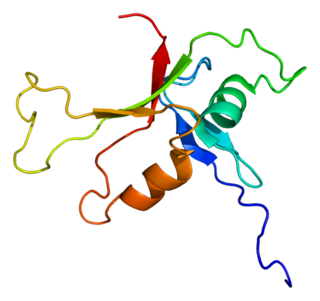1-Phosphatidylinositol-4,5-bisphosphate phospholipase beta-1 is an enzyme that in humans is encoded by the PLCB1 gene. [5] [6] [7]
1-Phosphatidylinositol-4,5-bisphosphate phospholipase beta-1 is an enzyme that in humans is encoded by the PLCB1 gene. [5] [6] [7]
The protein encoded by this gene catalyzes the formation of inositol 1,4,5-trisphosphate and diacylglycerol from phosphatidylinositol 4,5-bisphosphate. This reaction uses calcium as a cofactor and plays an important role in the intracellular transduction of many extracellular signals. This gene is activated by two G-protein alpha subunits, alpha-q and alpha-11. Two transcript variants encoding different isoforms have been found for this gene. [7]
Homozygous PLCB1 deletion is associated with malignant migrating partial seizures in infancy. [9]

Phosphoinositide phospholipase C is a family of eukaryotic intracellular enzymes that play an important role in signal transduction processes. These enzymes belong to a larger superfamily of Phospholipase C. Other families of phospholipase C enzymes have been identified in bacteria and trypanosomes. Phospholipases C are phosphodiesterases.

Inositol 1,4,5-trisphosphate receptor type 1 is a protein that in humans is encoded by the ITPR1 gene.

Calcium/calmodulin-dependent protein kinase type II beta chain is an enzyme that in humans is encoded by the CAMK2B gene.

Serine/threonine-protein kinase D1 is an enzyme that in humans is encoded by the PRKD1 gene.

1-Phosphatidylinositol-4,5-bisphosphate phosphodiesterase gamma-2 is an enzyme that in humans is encoded by the PLCG2 gene.

Phospholipase C (PLC) is a class of membrane-associated enzymes that cleave phospholipids just before the phosphate group (see figure). It is most commonly taken to be synonymous with the human forms of this enzyme, which play an important role in eukaryotic cell physiology, in particular signal transduction pathways. Phospholipase C's role in signal transduction is its cleavage of phosphatidylinositol 4,5-bisphosphate (PIP2) into diacyl glycerol (DAG) and inositol 1,4,5-trisphosphate (IP3), which serve as second messengers. Activators of each PLC vary, but typically include heterotrimeric G protein subunits, protein tyrosine kinases, small G proteins, Ca2+, and phospholipids.

Phosphatidylinositol-4,5-bisphosphate 3-kinase catalytic subunit beta isoform is an enzyme that in humans is encoded by the PIK3CB gene.

1-Phosphatidylinositol-4,5-bisphosphate phosphodiesterase beta-2 is an enzyme that in humans is encoded by the PLCB2 gene.

Serine/threonine-protein kinase D3 (PKD3) or PKC-nu is an enzyme that in humans is encoded by the PRKD3 gene.

1-Phosphatidylinositol-4,5-bisphosphate phosphodiesterase beta-3 is an enzyme that in humans is encoded by the PLCB3 gene.

1-Phosphatidylinositol-4,5-bisphosphate phosphodiesterase delta-1 is an enzyme that in humans is encoded by the PLCD1 gene. PLCd1 is essential to maintain homeostasis of the skin.

Phosphatidylinositol-4-phosphate 3-kinase C2 domain-containing alpha polypeptide is an enzyme that in humans is encoded by the PIK3C2A gene.

Phosphatidylinositol 3-kinase catalytic subunit type 3 is an enzyme subunit that in humans is encoded by the PIK3C3 gene. It's a class III phosphoinositide 3-kinase.

Phospholipase C epsilon 1 (PLCE1) is an enzyme that in humans is encoded by the PLCE1 gene. This gene encodes a phospholipase enzyme (PLCE1) that catalyzes the hydrolysis of phosphatidylinositol-4,5-bisphosphate to generate two second messengers: inositol 1,4,5-triphosphate (IP3) and diacylglycerol (DAG). Mutations in this gene cause early-onset nephrotic syndrome and have been associated with respiratory chain deficiency with diffuse mesangial sclerosis.

Phosphatidylinositol-4-phosphate 3-kinase C2 domain-containing beta polypeptide is an enzyme that in humans is encoded by the PIK3C2B gene.

1-Phosphatidylinositol-4,5-bisphosphate phosphodiesterase delta-3 is an enzyme that in humans is encoded by the PLCD3 gene.

1-Phosphatidylinositol-4,5-bisphosphate phosphodiesterase delta-4 is an enzyme that in humans is encoded by the PLCD4 gene.

1-Phosphatidylinositol-4,5-bisphosphate phosphodiesterase beta-4 is an enzyme that in humans is encoded by the PLCB4 gene.

Phosphatidylinositol-4-phosphate 3-kinase C2 domain-containing gamma polypeptide is an enzyme that in humans is encoded by the PIK3C2G gene.

Inositol 1,4,5-trisphosphate receptor, type 2, also known as ITPR2, is a protein which in humans is encoded by the ITPR2 gene. The protein encoded by this gene is both a receptor for inositol triphosphate and a calcium channel.